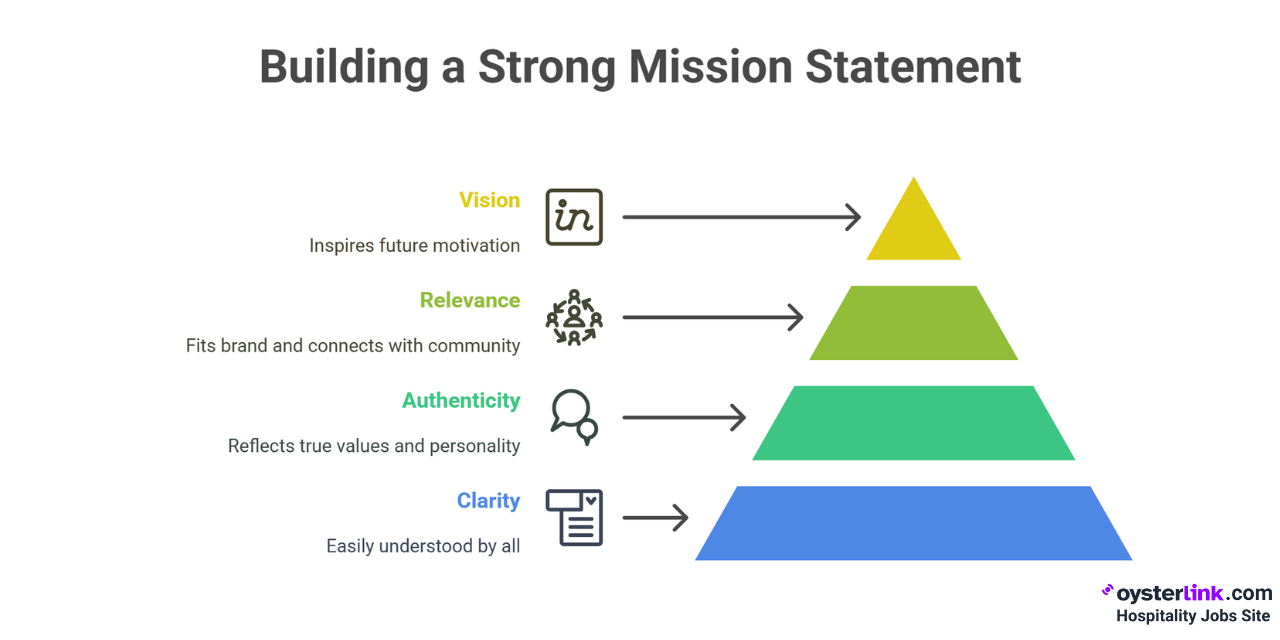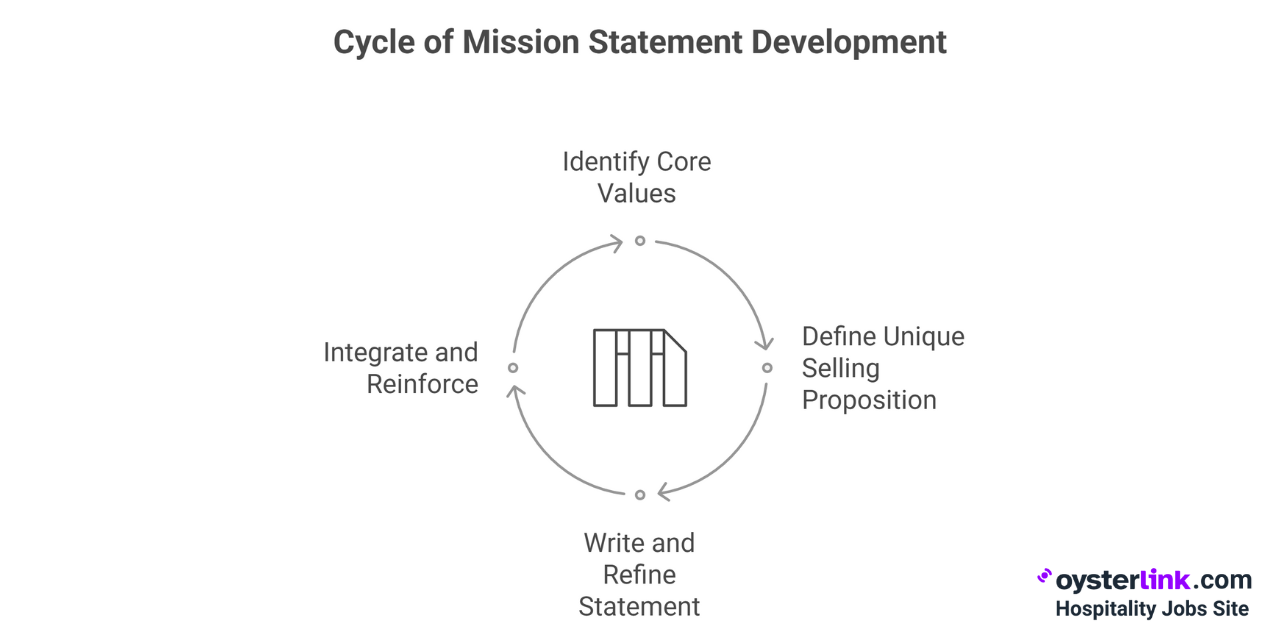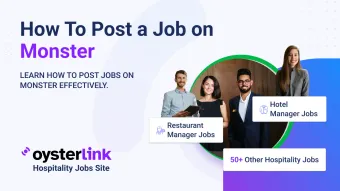Restaurant Mission Statement: Key Takeaways
- A restaurant mission statement summarizes your establishment’s core purpose, values and goals in one to two sentences — think of it as your restaurant’s “north star.”
- An effective mission statement not only guides team decisions but creates a consistent, memorable experience for guests and staff alike.
- Mission statements vary with restaurant style — from fine dining to fast casual — and should reflect your unique identity and “special sauce.”
A clear, authentic mission statement can help clarify your purpose, guide your team and connect with your community.
In this article, you'll find tips, examples and actionable steps to craft or update your restaurant's mission statement.
What Is a Restaurant Mission Statement?
A restaurant mission statement is a brief declaration that sums up the restaurant’s core purpose, goals and values.
It tells guests and staff what the restaurant stands for, why it exists and what makes it different.
Think of it as the guiding star behind decisions made by everyone — from the Chef to the Dishwasher.
Mission statements matter because they establish your restaurant’s identity, ensure team alignment and set the tone for the guest experience.
Purpose of a mission statement
A mission statement is more than just a slogan. It gives every team member — from the Sous Chef to the Event Planner — a clear sense of purpose and a framework for making everyday decisions.
It also sets expectations for guests and helps build a loyal following rooted in trust.
With a clearly communicated mission, choices become simpler and the customer experience becomes reliably consistent, no matter who’s on shift.
Regularly referencing your mission can cultivate staff pride and a spirit of collaboration — especially as your team grows.
Key elements of a strong restaurant mission statement
Here are the key elements to focus on when creating a strong restaurant mission statement:
- Clarity: The statement should be straightforward and easily understood by anyone, new team members and guests alike.
- Authenticity: It must reflect your true values — skip the buzzwords and let your unique personality come through.
- Relevance: The message should genuinely fit your brand and connect with your target community and customers.
- Vision: It should offer inspiration for the future, motivating both your staff and your guests for what’s ahead.

How To Write an Effective Restaurant Mission Statement
Writing a mission statement might feel intimidating, but breaking it down and involving your team makes it much easier.
Here’s a simple, step-by-step approach to crafting one that truly reflects your restaurant and gets everyone behind it.

Step 1: Identify your restaurant’s core values and vision
Start by asking, “What truly matters to my restaurant and our guests?” Do you prioritize sustainability, warm hospitality or showcasing local flavors?
Reflect on the experience you want every guest to have when they walk through your doors.
Consider gathering team input — ask your Host, Bartender or Line Cook to share what they think makes your restaurant special.
This groundwork makes your mission statement authentic and ensures buy-in across the team.
Step 2: Define your unique selling proposition
What will guests remember about your restaurant when they leave? Maybe it’s your farm-to-table sourcing, a signature dish or a community atmosphere where everyone feels welcome.
Identify the “special sauce” that sets you apart and makes your restaurant valuable to your customers.
Incorporate these ideas to highlight your difference in a genuine way — beyond food and décor.
Step 3: Write and refine the statement
Draft a statement that’s concise, energetic and authentic to you. Read it aloud with your team — if it resonates, it’s on the right track; if not, keep refining.
Edit until you have a phrase that’s easy for anyone to remember and feels true to your values and aspirations.
Step 4: Integrate and reinforce
Your mission statement is most powerful when it’s visible and actionable. Display it in your kitchen, staff room, menus and website.
Bring it into staff meetings and training so everyone knows how their role connects to the mission.
Make it part of your restaurant’s story that guests can connect with and rally behind.
Restaurant Mission Statement Examples
Need inspiration? Here are real-world mission statements for different restaurant types, with explanations for why each one resonates.
Consider how you might tailor these to your community-focused bistro or use them as a launching point for your team discussions.
Fine dining restaurant examples
“To create memorable dining experiences by combining culinary artistry with impeccable service in an elegant setting.”
This mission is aspirational and emphasizes the complete, elevated experience fine dining is known for.
“Our mission is to celebrate the finest ingredients, prepared with passion, served with warmth and sophistication.”
It highlights quality, passion and hospitality — central values in the world of fine dining.
Fast food and chain restaurant examples
“To serve fresh, affordable food, fast — so you can get on with your day.”
Simple and direct, this emphasizes speed and value while prioritizing customers’ needs.
“We make people happy through quick, quality meals and friendly service every time.”
Puts the customer first and speaks to consistency and a positive experience, key for any chain.
Café and casual restaurant examples
“Bringing the community together — one cup and conversation at a time.”
This sets an inviting tone and highlights a community focus that’s especially relevant to neighborhood cafes and bistros.
“Simple, delicious food served in a relaxed neighborhood setting.”
Emphasizes comfort, approachability and daily enjoyment — perfect for owner-operated casual spots.
Examples for specific concepts
Vegan restaurant: “To inspire conscious choices by delighting our guests with plant-based cuisine and compassion for every being.”
Shows a clear ethical standpoint and a commitment to positive change.
Farm-to-table restaurant: “Celebrating local farmers and seasonal flavors in every dish we create.”
Highlights local partnerships and freshness — ideal for sustainability-focused brands and bistros.
Authentic Mexican restaurant: “Sharing the vibrant flavors and warmth of Mexico with every meal.”
Communicates authenticity, pride and hospitality — core values for concept-driven establishments.
Community-focused bistro example
“Rooted in our neighborhood, we create comfort food with heart using local farms and honest hospitality — so everyone feels at home.”
This example speaks directly to independent owners like you — emphasizing local sourcing, genuine hospitality and community roots.
Tips for Creating a Memorable Restaurant Mission Statement
- Keep it short — one or two sentences at most so everyone can say it by heart.
- Use plain, genuine language that resonates with your team and guests — skip trendy buzzwords.
- Tap into emotion — your statement should reflect the passion and values that inspired you to open your doors.
- Stay true to your brand and story — let your restaurant’s personality shine through, not someone else’s template.
- Bring your team into the process for feedback and energy — it’ll help with both buy-in and retention.
- Review your mission regularly, especially after menu changes, renovations or milestone community events to ensure it still feels right.
- Display your mission statement in visible places for both staff and guests for ongoing inspiration and trust-building.
A memorable mission statement reflects your restaurant’s unique story and is the daily promise you and your team live up to.
How To Integrate Your Mission Statement Into Daily Operations
Here are some practical ways to weave your mission statement into the daily life of your restaurant:
- Team meetings: Kick off weekly meetings by reading your mission statement and inviting feedback or stories about how staff brought it to life that week.
- Training: Incorporate the mission into new hire orientation and training manuals; encourage new staff to share how they connect with it.
- Marketing: Weave your mission into your “About Us” page, menus, social media bios and press materials — tell the story behind the food.
- Community engagement: Reference your mission when partnering with local organizations or hosting neighborhood events. Let guests see the connection between your words and your actions.
- Annual reviews: Ask your team what the mission means to them during annual evaluations or after major milestones to keep it relevant and alive.
When your mission is visible, actionable and connected to everyday interactions, it becomes much more than just a phrase — it’s the backbone of your brand and team culture.










Loading comments...